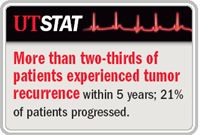Article
Restaging TUR predicts risk of bladder cancer progression
Author(s):
Atlanta-Conducting a second transurethral resection to restage bladder cancer should be a routine practice, according to Harry Herr, MD, attending physician at Memorial Sloan-Kettering Cancer Center, New York. The results are diagnostic, therapeutic, and invaluably prognostic, he said.

At the 2006 AUA annual meeting, Dr. Herr presented data supporting a long-standing argument that he has made and a routine of conducting follow-up TURs that he has practiced for as long as he has made the argument.

The primary finding of this study was that most patients (76%) with high-grade invasive (T1) cancer on restaging progressed to life-threatening muscle-invasive cancer despite receiving the standard bladder-sparing TUR and Bacillus Calmette-Guérin (TheraCys, TICE BCG) therapy. An additional finding, one that the doctor has perhaps been anticipating for years, was that restaging TUR (reTUR) findings are more reliable and more accurate than are BCG response evaluations with cystoscopy when it comes to identifying patients at high risk of progression. The findings do not necessarily apply to low-grade tumors.
To arrive at these conclusions, Dr. Herr and his colleague, S. Machele Donat, MD, evaluated 710 patients who presented with one or more superficial bladder tumors between 1993 and 2000. All patients underwent reTUR within 4 months of their initial TUR, regardless of the institution at which the TUR was performed. Patients with high-grade tumors were given one or more courses of BCG therapy following reTUR. Responses to the first course of BCG were evaluated by cystoscopy before a second course of BCG was applied.
More than two-thirds (69%) of the 710 patients experienced tumor recurrence within 5 years, and 149 patients (21%) progressed. Eighty patients were found to have high-grade invasive (T1G3) cancer on reTUR; 61 (76%) of these progressed to muscle-invasive cancer.
Five percent of the low-grade tumors were upgraded after reTUR, but none were upstaged compared with 15% of the high-grade tumors that were upstaged on reTUR.
No progression was seen in 356 patients found to have no tumors or low-grade papillary tumors on reTUR. Progression was seen in 76% of those patients found to have residual T1 tumors. Median time to progression was 15 months. Multivariate analysis showed the most significant factor predicting early progression was reTUR pathology (p≥.000), followed by the response found on first follow-up cystoscopy (p=.001), presence of carcinoma in situ (p=.002), initial tumor stage (p=.02), and grade (p=.8).
"If a patient presents with T1 cancer, the standard initial approach is to treat them with BCG and rebiopsy, and continue to be conservative," Dr. Herr said. "That, in fact, is successful in many instances.
"But if we restage that patient and they still have T1 disease, meaning residual invasive cancer that has yet to invade muscle, that patient is unlikely to respond to BCG. Even if they do respond, they are rapidly going to develop invasive cancer. That is a patient who most likely should be treated with cystectomy right off the bat," he added.
It is not that the pathologic information is better than the first response to BCG, Dr. Herr explained. The information portends a poor outcome with conservative treatment. ReTUR allows this to be determined earlier in the clinical course than does waiting to determine local response.















